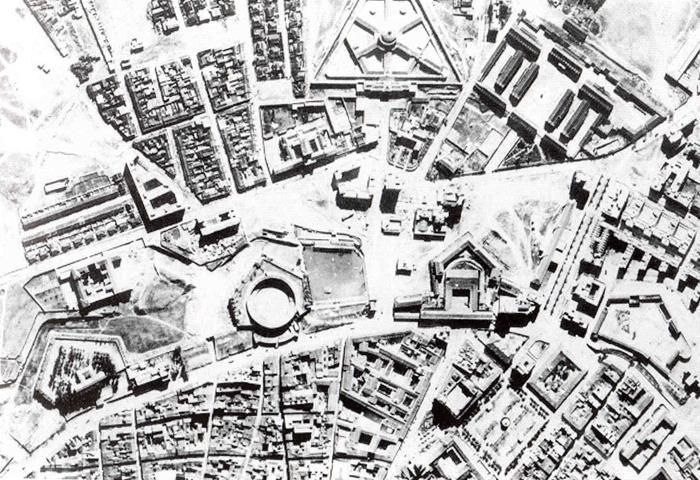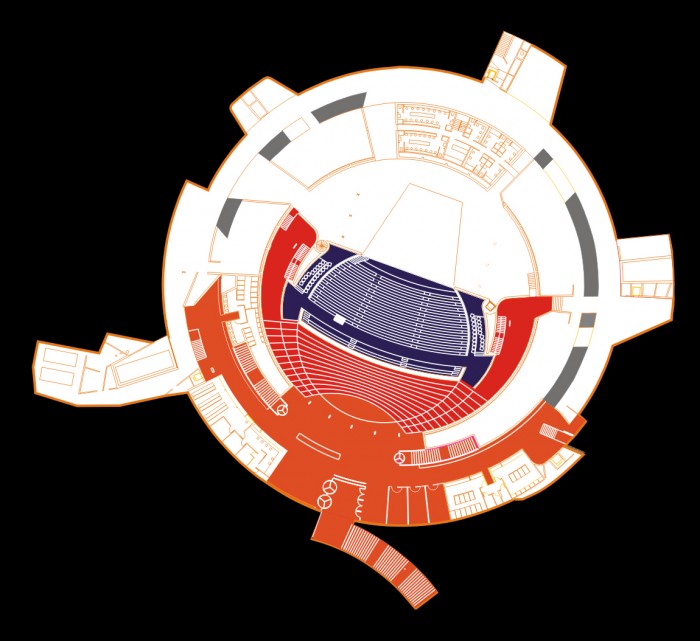1999-2006. trucar: La base sobre la que trabajar es bastante irrepetible, extraña: la antigua plaza de toros de la ciudad, circular, inserida en un bastión pentagonal de la muralla Vauban del S. XVII.
Desde la memoria del concurso hemos pedido disculpas siempre por usar como partida una cita de Leopardi: “El último grado del saber consiste en reconocer que todo lo que buscábamos estaba siempre delante de nuestros ojos.” Con ella resumíamos el proceso de cómo la, en un principio, dificultad de actuación en este condicionado lugar, pasó a obviedad al reconocer que lo que buscábamos ya existía.
Creado para la ciudad de Badajoz en el concreto enclave del Baluarte de San Roque sobre los restos de las antiguas plazas de toros que han ido existiendo en ese lugar. Para nosotros tiene importancia el proceso palimpséstico de todas esas anteriores plazas y sus evoluciones, y no sólo la última con la que nos encontramos al llegar al lugar. No nos importa el echo físico de algo que además ya no existe sino la condición creada previamente, en el siglo XVIII, por la decisión de vaciar un círculo en un masivo baluarte pentagonal distorsionándole todo el concepto que tenía de defensivo y darle la vuelta haciéndolo receptivo al acceso y al acto público; que puede ser tanto una corrida de toros, como un concierto o un congreso. Por tanto nuestra decisión desde un principio fue mantener esta condición de vacío público, de vacío ganado a la ciudad.
Para conservarlo nos “limitamos” a abarcar todo ese ámbito existente, rellenándolo absolutamente.
La dificultad de aplicar aquí este sistema de colmatar una parcela se da porque ésta consiste en un vacío circular sobre un bastión, y como tal debe continuar. La complejidad de colocar un Palacio de Congresos en un vacío y que este continúe vacío viene resuelto mediante un fácil truco, truco de magia, truco que consiste en invertir la zona de los espectadores y llevarla al albero, al centro, y el vacío centro llevarlo alrededor de los espectadores, al lugar de las antiguas gradas. Después el cilindro que se nos produce en el centro lo vestimos con luz para que desaparezca proyectado sobre los anillos exteriores de poliéster que me marcan el incierto límite de un vacío. Por supuesto el truco viene preparado por la colocación bajo tierra y bajo el bastión del mayor número posible de elementos del programa. –en disposición de elementos radiales proyectándose al centro.
Desde fuera se podría pensar que la marquesina de la entrada principal es la única construcción o manivela que aparece, representa y abre, bajando por la escalera a la que cubre, todo el edificio.
Desde dentro la sala principal corresponde a la misma idea exterior del cilindro con paredes luminosas del mismo material acrílico, techo translúcido a modo de cañizo sobre el que se mueve la sombra del óculo y suelo del mismo color oscuro que la plaza y patio exterior.
Desde fuera, esta obra, ya casi finalizada, ha ido creando en general una gran inquietud: cuanto más se trabajaba en ella, en vez de aparecer, desaparece. Desaparece diluida en esa herencia que asumimos.
Ficha Técnica
Nombre del proyecto: Palacio de Congresos y exposiciones de Badajoz.
Arquitectos: José Selgas y Lucia Cano
Colaboradores: Lara Resco, José de Villar, Talia Dombriz, Paula rosales, Blas Antón, Cesar Gª Guerra, Ángel Azagra, Miguel San Millán, Manuel Cifuentes, Carlos Chacón, Brigitte Hollega, Mara Sánchez, Juan Bueno, Fabián Fdez de Alarcón,
Estructuras: José Romo (Fhecor)
Ingeniería Poliester: Juan Sobrino (Pedelta)
Ingeniería mecánica: JG Asociados
Acústica: Higini Arau (Arau Acustic)
Diseño de butacas auditorio: Monica Förster
Contrucción : 2006
The base on which we work is rather unrepeatable, strange: the old bullring of the city, circular, inserted in a pentagonal bastion of the Vauban XVII century wall. In the contest final report we have always excused ourselves for using a quote from Leopardi as our headword: “The last stage of knowledge is recognizing that all we were looking for was always in front of our eyes”. With this quote we summarized the process of how the initial difficulty involved in acting in such a conditioned place became resolved when we realized that what we were looking for already existed.
The bullring was created for the city of Badajoz in the specific enclave of the Baluard of San Roque over the remains of the old bullrings that have existed there throughout the centuries. We consider of great importance the palimpsestic process of all the previous bullrings and their evolutions, not only the last one we encounter in that site. We are not concerned with the physical echo of what is no longer there, but rather with the condition created previously, in the XVIII century, by the decision of emptying a circle in a massive pentagonal bastion, distorting the whole defensive concept and turning it around to make it receptive to public access and public events, either a bullfight, a concert or a conference. Therefore our decision from the beginning was to maintain this condition of a public empty space, of a space taken from the city. In order to maintain it, we “limited” ourselves to covering the whole existing field, filling it in completely. The difficulty in applying this procedure to fill a plot of land is due to the fact that it is a circular void on a bastion and so it must remain.
The complexity of placing a Conference Centre in an empty space and maintaining it empty is resolved by means of a simple trick, a magic trick, consisting of inverting the spectator area and taking it to the ring, to the centre, and taking the empty central area to the spectators, to where the old stands used to be. Then we dress the cylinder that is produced in the centre with light, projected upon the outer polyester rings that mark the uncertain limits of a void. Of course, the trick is prepared by placing underground and under the bastion the greatest possible number of elements of the program, placed in a radial position projecting towards the centre.
From the outside we might think that the shelter of the main entrance is the only existing construction or crank that appears, represents and opens, down the staircase it covers, the whole building.
From the inside, the main room corresponds to the same exterior idea of the cyclinder with luminous walls of the same acrylic material, translucid ceiling in the shape of a grid on which the shadow of the óculo moves, and a floor of the same dark colour as the plaza and the external patio. From the outside, this work, almost finished, has been creating, overall, a great unrest: the more we work on it, instead of appearing, it disappears. Diluted in that inevitable heritage.
Design team:
José Selgas y Lucia Cano
Project partners:
ARCHITECTS COLLABORATORS
Lara Resco, José de Villar, Talia Dombriz, Paula rosales, Blas Antón, Cesar Gª Guerra, Ángel Azagra, Miguel San Millán, Manuel Cifuentes, Carlos Chacón, Brigitte Hollega, Mara Sánchez, Juan Bueno, Fabián Fdez de Alarcón,
ESTRUCTURAL ENGINEERS
José Romo (Fhecor)
POLYESTER ENGINEERS
Juan Sobrino (Pedelta)
MECHANICAL ENGINEERS
JG Asociados
ACOUSTIC
Higini Arau (Arau Acustic)
AUDITORIUM CHAIR DESIGN
Monica Förster
MODEL
Juan de Dios Hernández y Jesús Rey


















1 comentario